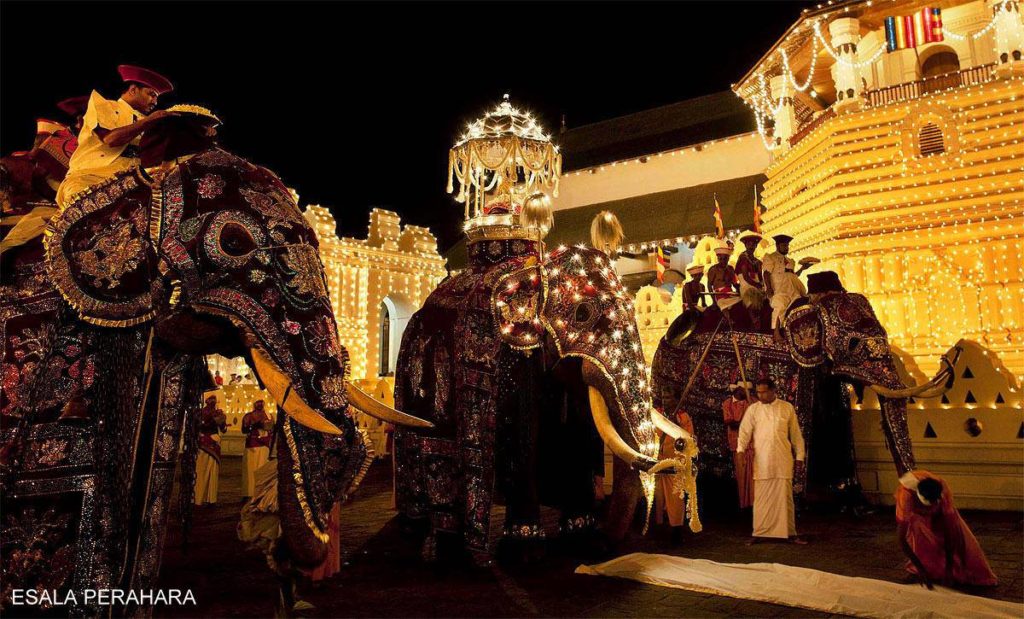

The official name of this nation is the Democratic Socialist Republic of Sri Lanka. In 1972, the national constitution discarded the name Ceylon and adopted the name of Sri Lanka. In Sinhala, the language of the majority, Sri means “blessed” & Lanka is the name of this island.
The island’s history of immigration, trade, and colonial invasion has led to the formation of a variety of ethnic groups, each with its own language and religious traditions. Besides the majority Sinhala Buddhists, the nation also includes Sri Lankan Tamils, Tamils of recent Indian origin, Muslims, semitribal Väddas, and Burghers, descendants of intermarriages between Sri Lankans and Europeans.
Sri Lanka’s staple meal is a large serving of rice accompanied by up to twelve different side dishes of vegetables, egg, meat, or fish stewed together with peppers, spices, and often coconut milk. This rice and curry meal is traditionally eaten at midday, although it may also be served in the evening. The traditional morning and evening meals are usually composed of a traditional starchy staple, such as string hoppers (fresh rice noodles), hoppers (cup-shaped pancakes), roti (coconut flat bread), or thosai (sourdough pancakes), served with a sambol (a mixture of hot peppers and other vegetables, served cool) and one or two curries.A variety of snacks and beverages are also eaten periodically throughout the day. Strong, sweat tea, usually with milk, is drunk alone or following a small serving of finger food or sweets, especially at mid-morning and late afternoon. Curd, a yogurt made from the milk of water buffaloes or cows, is often served as a dessert with palm syrup or sugar. A rich variety of fruits is available year-round.
Sri Lanka’s economy is shifting away from its traditional agricultural base to include production for an international market, a shift accelerated by a major policy change in the 1977 transition from a socialist-style, state controlled economy to a free market economy lead by the private sector. By the mid-1990s, roughly one-quarter of the population was employed as skilled workers in agriculture, fishing, or animal husbandry; one-quarter in skilled craft or factory production; one-quarter in administration, medicine, law, education, accounting, sales, services, or clerical work; and one-quarter as unskilled laborers. In spite of this shift away from agriculture, Sri Lanka has recently achieved near self-sufficiency in rice production and other staple foods.
Even though the ideal of social equality is widely diffused in contemporary Sri Lanka, stratification according to caste and class, as well as gender and ethnicity, continues to be very important. Class is determined by attributes such as wealth and education while caste, a traditional part of Hindu and Buddhist society in Sri Lanka, is determined by birth into a predetermined status hierarchy, typically understood as a matter of reward or retribution for one’s deeds in previous lives. The traditional correspondence between these statuses was upset by 450 years of colonial rulers who often privileged members of certain, relatively low-status castes, effectively raising their class status and that of their offspring. The importance and legitimacy of caste continues to be undermined by political and economic developments. Class differentiation, on the other hand, is increasing both in day-to-day social interaction and manifestations of disparities.
In Sri Lanka, there is a strong tradition of both men and women working, with men focusing more on income opportunities and women focusing on the household. Currently, women’s participation in the paid labor force is significant, although not evenly distributed, concentrated in professions such as nursing, teaching, tea picking, and garment construction. In manufacture and agricultural work, men are typically assigned tasks considered more physically demanding, while women are assigned the more repetitive, detail-oriented work at which they are thought to be better than men.
In all ethnic groups, marriages are traditionally arranged by the families of the couple. “Love marriages” initiated by the couples themselves are, however, increasingly common. Regardless of who initiates the marriage, the bride and groom are expected to be of the same socioeconomic status, ethnicity, and, for Buddhists and Hindus, caste status, although the groom is expected to be slightly older, taller, and educationally and professionally more qualified than the bride.
Ideally, a husband and wife live in their own household with their unmarried children, even if that household is actually a small section of an extended family home. In Sri Lanka, individual households are identified by cooking practices, so that, even within a larger house, a wife will cook for her husband and children independently from others who may live within the structure, perhaps sharing the same kitchen.
Buddhism, the religion of the majority of people in Sri Lanka, is given a place of preference in the national constitution and public life, although Hinduism, Islam, and Christianity are also practiced by significant portions of the population. Except in the case of Christians, who are drawn from a variety of ethnic groups, these religious traditions map directly onto the three major ethnic groups: Sinhala/Buddhist, Tamil/Hindu, and Muslims.
All Saturdays and Sundays are public holidays, as is the Poya Day of each month which marks the full moon. Independence Day on 4 February and May Day on 1 May are also public holidays. During April, the island largely shuts down for a week as its Sinhala and Tamil residents celebrate the traditional new year, the exact day of which is determined by astrologers. In addition, the major Buddhist, Hindu, Muslim, and Christian days are also reserved as public holidays.
Read More on Wiki: https://en.wikipedia.org/wiki/Culture_of_Sri_Lanka
